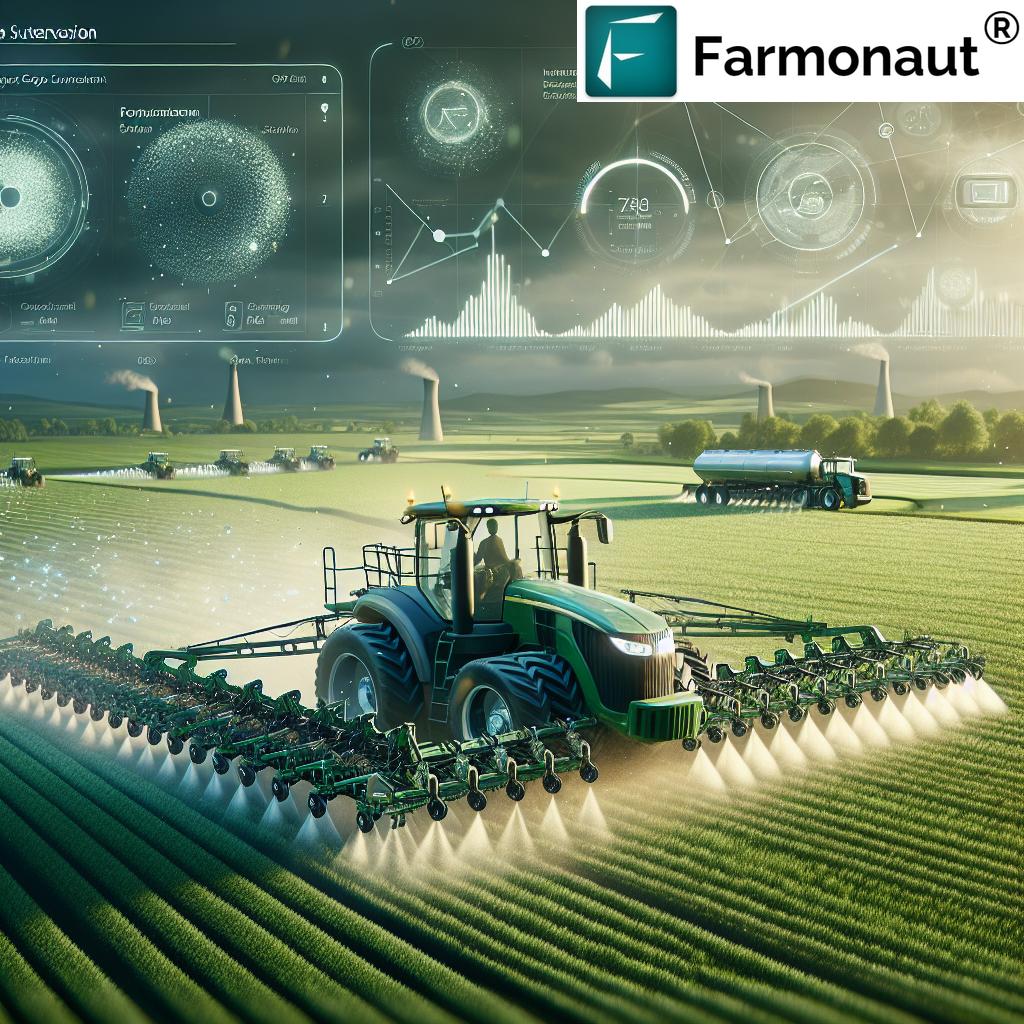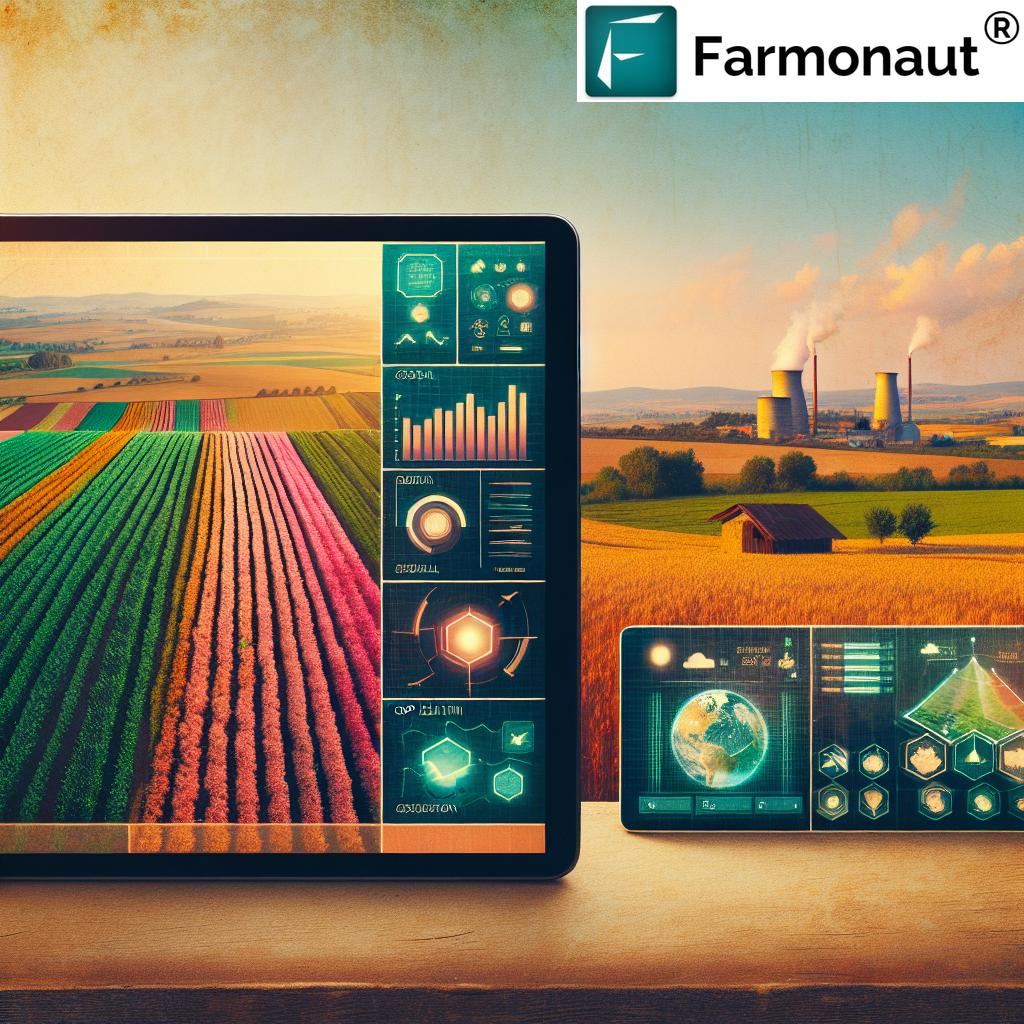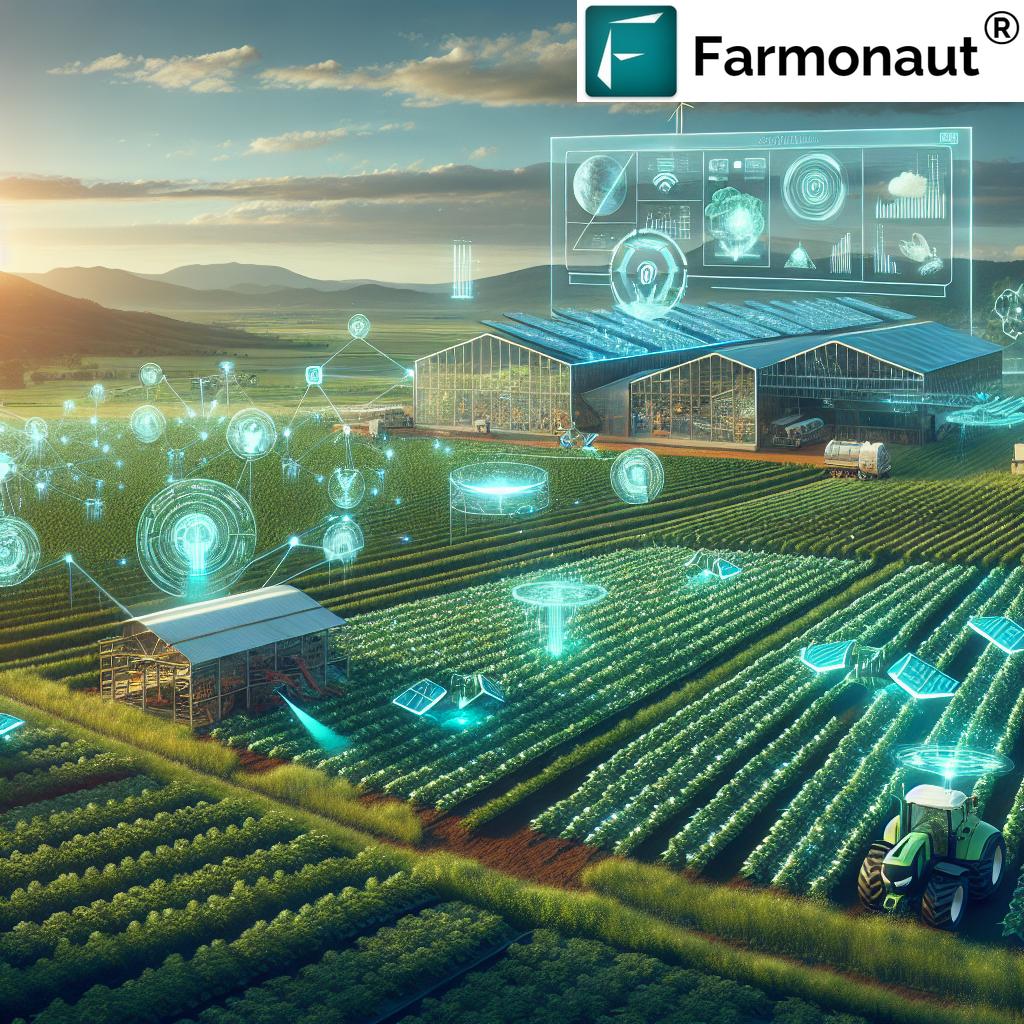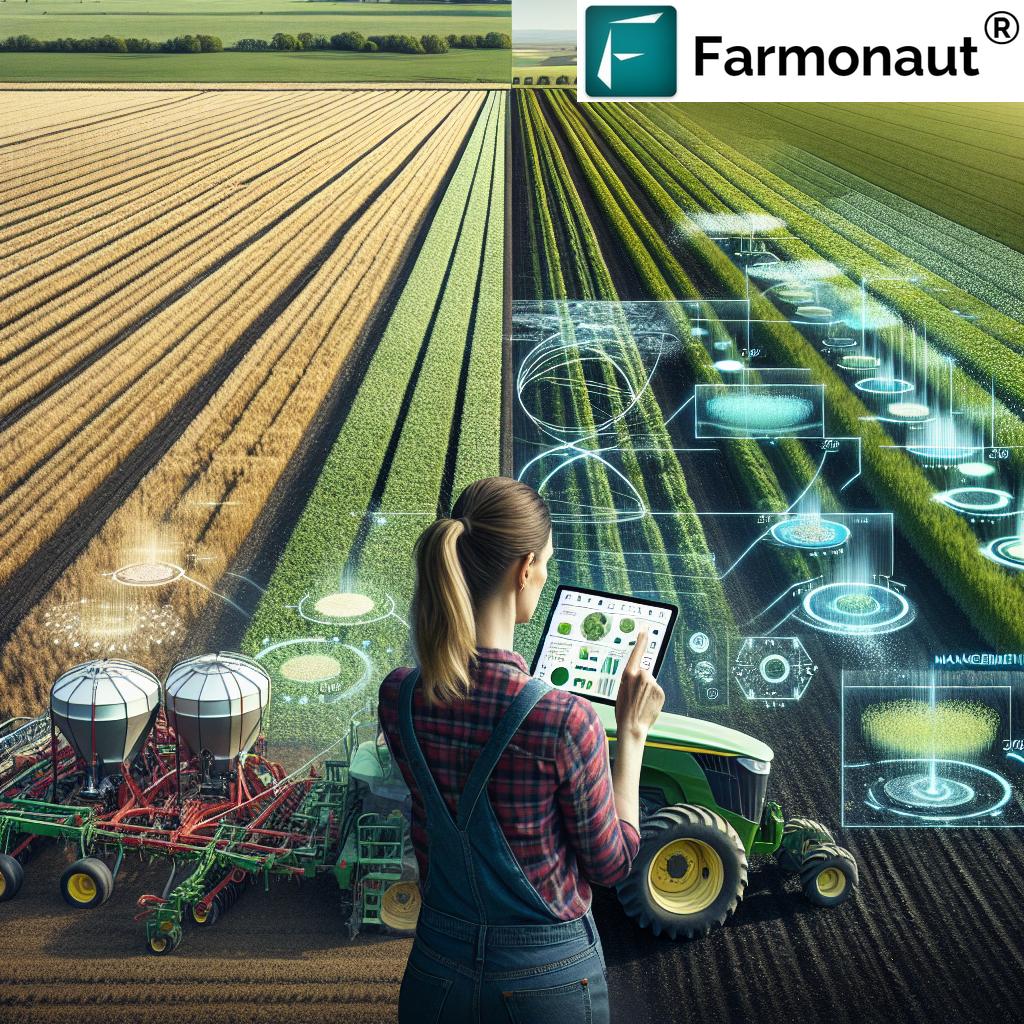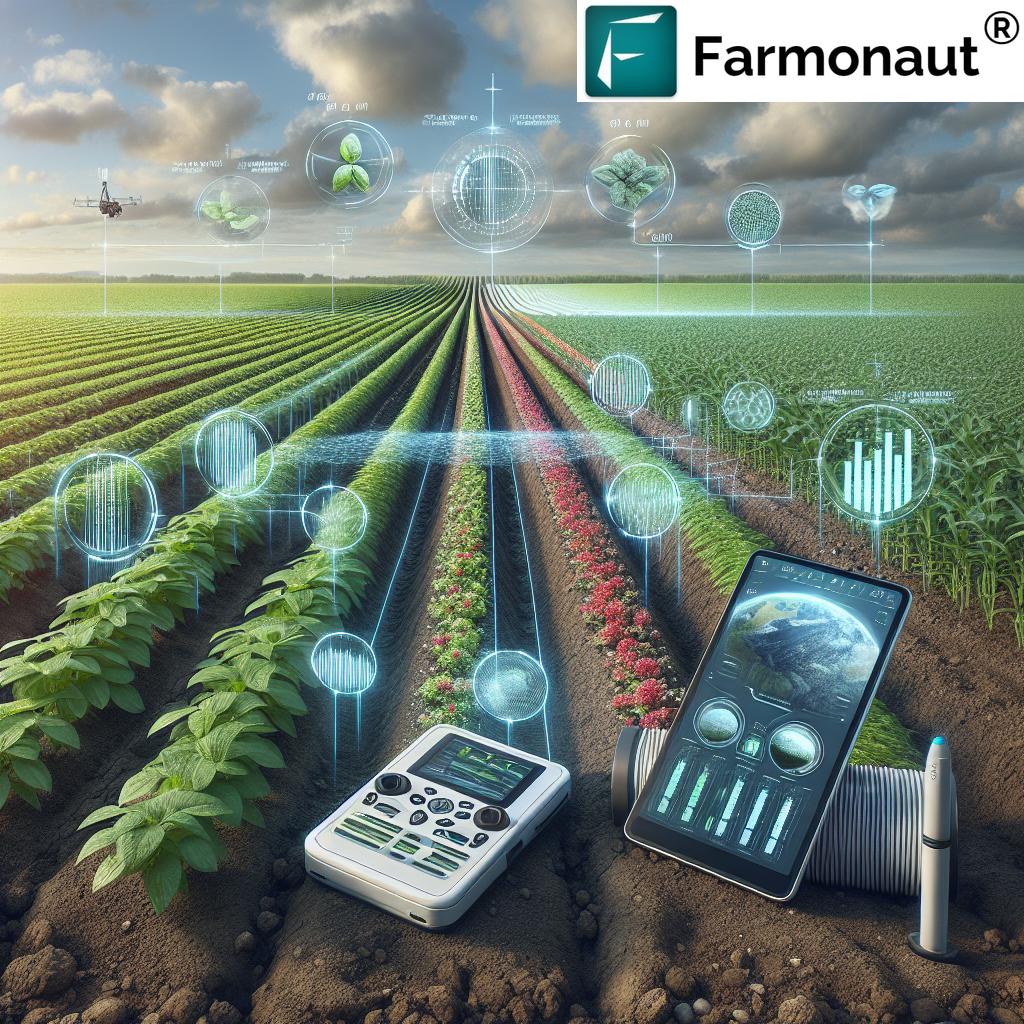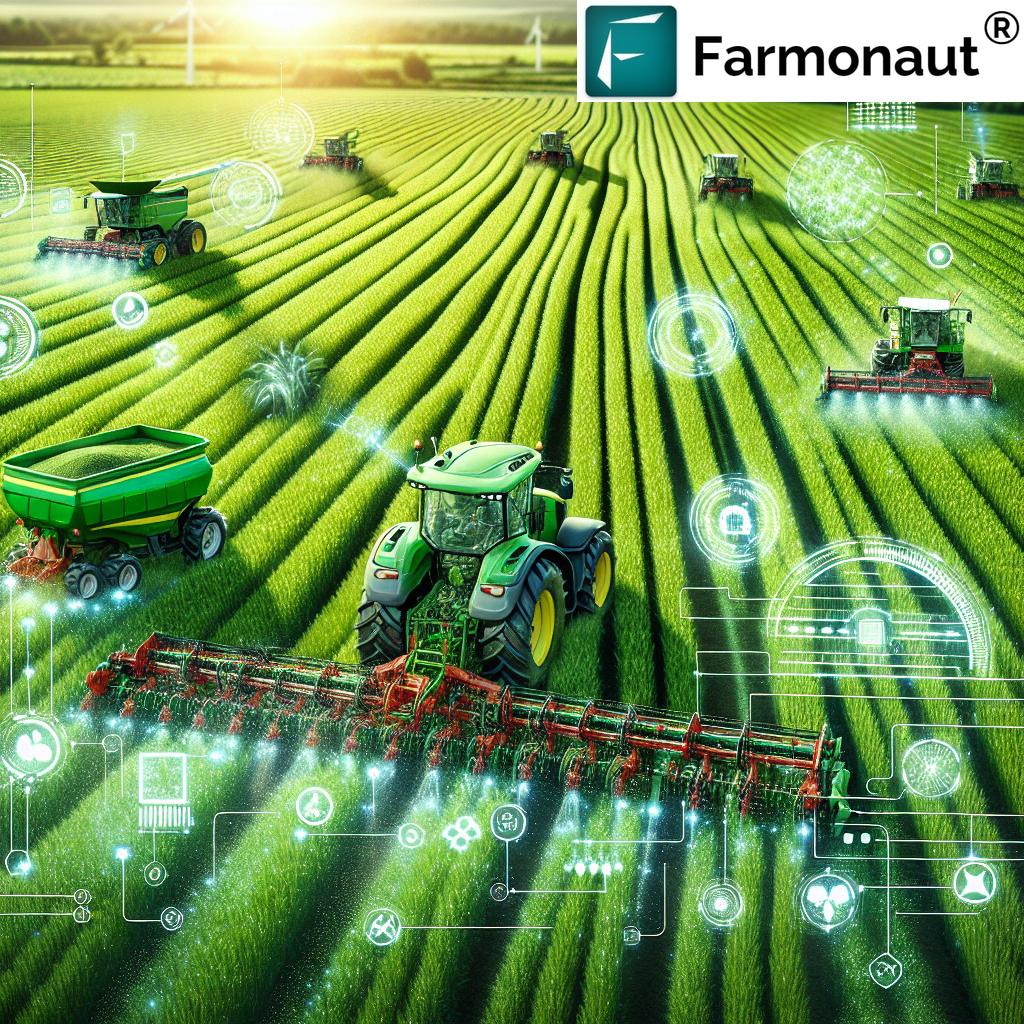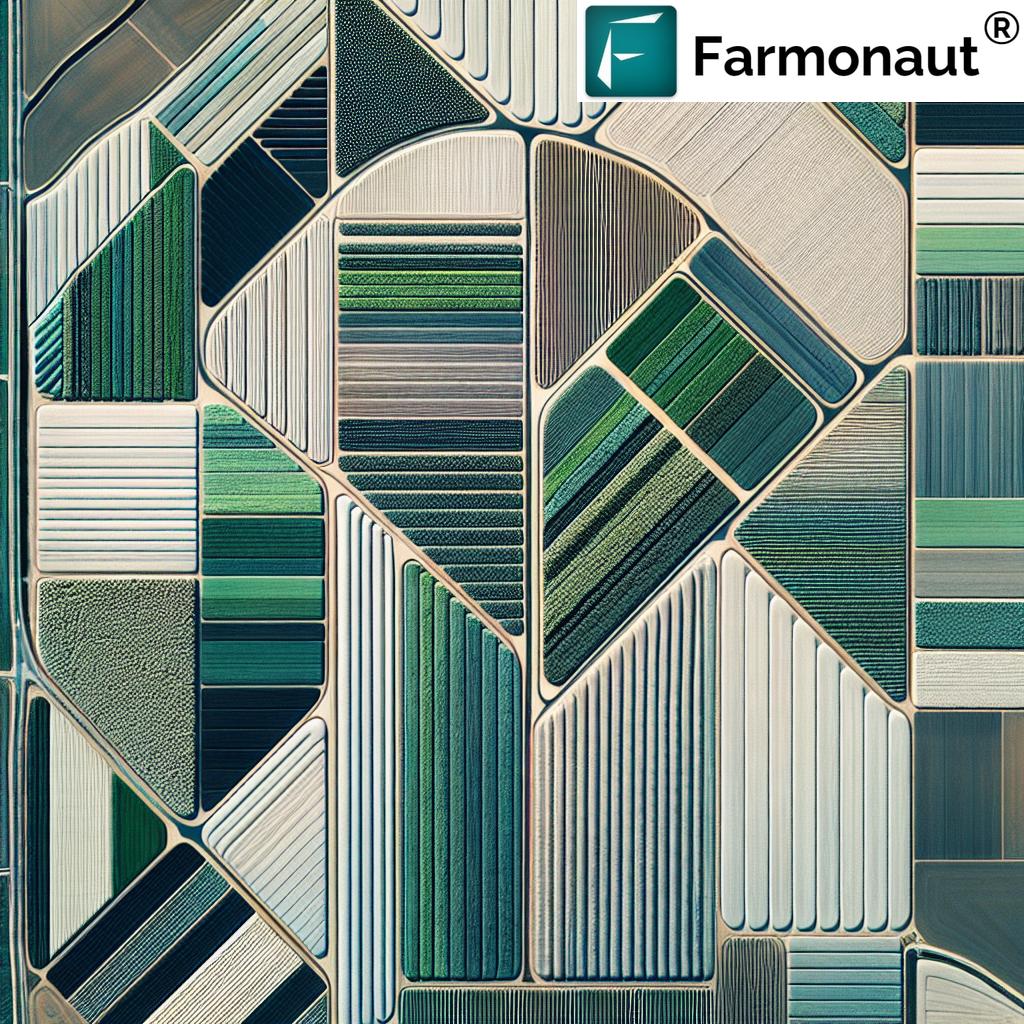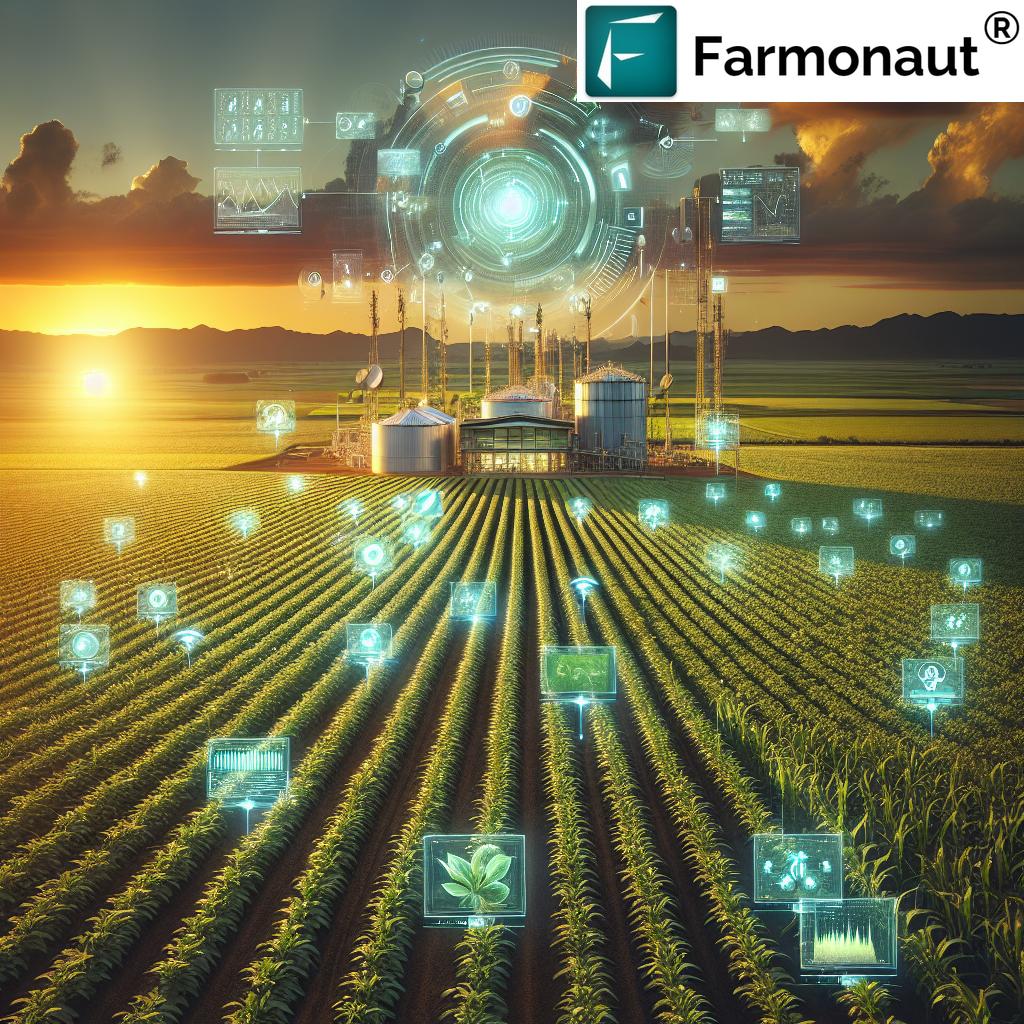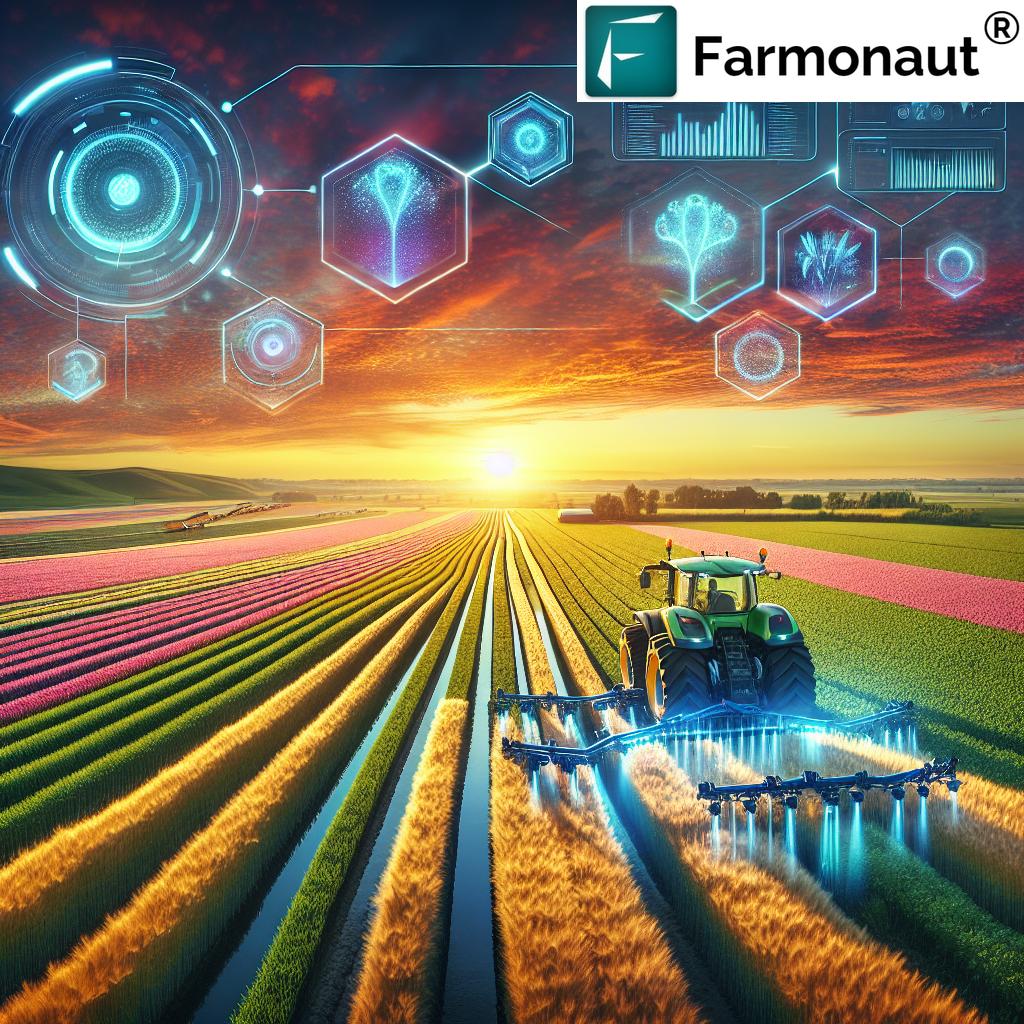Precision Farming Entry-Level: 7 Game-Changing Technologies
Table of Contents
- Introduction to Precision Farming
- Understanding Precision Farming: Core Concepts
- Did You Know?
- 7 Game-Changing Precision Agriculture Technologies
- Technology Comparison Table
- Implementing Precision Farming: Step-by-Step Guide
- Farmonaut – Making Advanced Precision Farming Accessible
- Precision Farming Trivia
- Overcoming Entry-Level Challenges in Precision Agriculture
- The Future of Innovative Precision Farming
- Precision Farming FAQs
- Conclusion: Stepping into the Future of Sustainable Agriculture
Precision farming is driving an agricultural revolution by merging advanced technologies, data, and artificial intelligence (AI) with traditional farming practices. At its heart, this innovative approach empowers us as farmers to take control, make informed decisions, and optimize every inch of our fields and resources for maximum productivity and sustainability.
“Over 70% of farmers using AI-powered analytics report increased crop yields within the first year of adoption.”
Understanding Precision Farming: Core Concepts
At its core, precision farming (also known as precision agriculture) is the use of advanced technologies and data-driven farming practices to monitor, analyze, and manage variability within our fields. By leveraging information from various digital and technological sources, we can ensure our crops and livestock receive the exact amount of nutrients, water, and care at precisely the right time and location.
- Optimize fertilizer or pesticide application by targeting specific areas in need
- Monitor field performance with sensors, satellite, or drone imagery
- Make informed decisions for each crop cycle based on data and analysis
- Promote environmental sustainability by minimizing waste and resource use
Precision farming is not about one-size-fits-all solutions. Instead, it is about tailoring our techniques to the unique challenges and opportunities present in every field we manage, whether in smallholding farms or large commercial operations. The collective result is improved yield quality, greater resource efficiency, and far less environmental impact.
“Remote sensing technology can monitor up to 10,000 acres of farmland in a single satellite pass.”
7 Game-Changing Precision Agriculture Technologies
Through years of research, practice, and innovation, several technologies have emerged as genuine “game-changers” for entry-level precision farming. Here, we’ll explore the seven that are having the most profound impact on how we monitor fields, enhance productivity, and promote sustainability worldwide.
-
Global Positioning System (GPS): Precise Positioning for Smart Agriculture
GPS technology is foundational to many precision agriculture technologies. By using satellite signals, GPS guided farming equipment – from tractors to harvesters – can navigate fields with sub-meter accuracy. This helps us:
- Perform precise mapping of fields to identify variability in soil and crops
- Enable automated steering systems, reducing overlap and optimizing fuel consumption
- Facilitate efficient input management by knowing exactly where fertilizers, seeds, or pesticides are applied
With GPS, we not only improve yield quality and quantity, but also manage our resources more efficiently—making every pass count.
-
Geographic Information System (GIS): Turning Data into Decisions
GIS software processes all the collected data from GPS, sensors, and aerial imagery. By overlaying information such as soil types, crop yields, terrain, and drainage, GIS enables us to:
- Create detailed maps of fields for better management
- Identify patterns of variability and make informed decisions about crop management
- Diagnose problems (like waterlogging or nutrient deficiency) with actionable intelligence
In essence, GIS connects “where” and “what,” so we can truly understand our fields and optimize them—one data layer at a time.
-
Remote Sensing: Eyes in the Sky for Real-Time Field Insights
Remote sensing in agriculture utilizes satellites, drones, or other aerial platforms to capture detailed data on crop health and field conditions. These advanced technologies allow us to:
- Monitor crop health using multispectral imaging (e.g., NDVI, EVI)
- Detect pest infestations, disease outbreaks, and nutrient deficiencies early
- Track soil moisture and irrigation needs across large fields
Farmonaut, for example, brings these benefits to any farmer’s fingertips by providing real-time satellite-based crop monitoring through web, mobile, and API applications.
-
Variable Rate Technology (VRT): Precision Input Application
Variable rate technology in agriculture enables us to apply seeds, fertilizers, pesticides, and even water at variable rates depending on the specific needs of each zone within a field. This smart approach helps us:
- Reduce input waste by targeting only areas requiring intervention
- Optimize costs and increase yields by tailoring input application
- Enhance environmental sustainability by preventing over-application
VRT supports the shift towards sustainable agriculture practices and tighter resource control, ultimately benefitting our soil and profitability.
-
Artificial Intelligence and Machine Learning: Smarter Farming Decisions
Artificial intelligence in farming unlocks new capabilities by analyzing limitless streams of sensor, weather, and satellite data. AI-driven models predict yields, anticipate pest or disease outbreaks, and recommend corrective actions. With AI, we can:
- Benefit from personalized, data-driven advisory systems such as Farmonaut’s Jeevn AI for crop management
- Deploy machine learning to recognize crop health trends and threats from imagery
- Optimize irrigation and input schedules for different crops and fields using automated insights
By leveraging AI, even smallholding farms can achieve “big data” sophistication, maximizing productivity and minimizing risk.
-
Farm Management Software and APIs: Centralized Control for Every Operator
All the technologies above work best when integrated into comprehensive systems. Leading platforms—such as Farmonaut’s, available for Android, iOS, web, and API here—allow us to:
- Access real-time data on soil, vegetation, and weather—without hardware installation
- Centralize management for multiple fields and locations
- Easily integrate with existing farm equipment and software
- Connect with developer-friendly APIs for custom workflows or digital products
With user-friendly dashboards, mapping tools, and AI-powered recommendations, anyone can harness the benefits of digital agriculture.
-
Blockchain for Traceability and Carbon Footprinting: Building Trust and Sustainability
Blockchain technology is revolutionizing supply chains in agriculture. With platforms like Farmonaut’s Product Traceability, we can:
- Track every product from field to consumer, building trust and transparency
- Enhance sustainability initiatives by accurately measuring carbon emissions with carbon footprinting tools
- Verify sustainable agriculture practices for certification and export requirements
- Justify responsible sourcing with certified, “blockchain-verified” records
These tools are especially valuable for both small and large producers seeking to meet market and regulatory demands for quality and environmental stewardship.
Comparison Table: 7 Game-Changing Precision Farming Technologies
| Technology Name | Description | Estimated Yield Improvement (%) | Estimated Cost Savings (%) | Environmental Impact | Adoption Level |
|---|---|---|---|---|---|
| GPS | Field mapping, automated steering in tractors, precise application zones | 8–12% | 5–10% | Reduced fuel, input overlap, minimized environmental footprint | Entry |
| GIS | Data overlay & analysis, spatial decision support, problem diagnosis | 10–15% | 8–12% | Targeted interventions reduce runoff & overuse | Entry–Intermediate |
| Remote Sensing | Satellite/drone imaging for real-time crop & soil health monitoring | 10–18% | 7–18% | Conserves water, decreases pesticide/fertilizer waste | Entry–Advanced |
| Variable Rate Technology (VRT) | Targeted input application based on field maps and soil data | 10–25% | 15–30% | Greatly reduced input waste and leaching | Intermediate |
| AI & Machine Learning | Predictive analytics for yield, pest, and resource management | 12–20% | 10–25% | Allows ultra-targeted management, reduces overuse | Entry–Advanced |
| Farm Management Software & APIs | Centralized analytics, mapping, and actionable insights | 8–15% | 8–18% | Supports sustainability with smarter decisions | Entry–Advanced |
| Blockchain for Traceability & Carbon Footprinting | Supply chain transparency, emissions reporting | Helps maintain/increase by quality assurance | Reduces fraud, supports premium pricing | Drives sustainability, incentivizes eco-practices | Entry–Advanced |
Note: Estimated yield and cost improvements are indicative. Results vary based on crop type, region, adoption level, and management practices.
Implementing Precision Farming: Step-by-Step Guide for Beginners
Embarking on your precision farming journey doesn’t need to be complex. Here’s our practical guide to starting with these innovative technologies and data-driven farming practices:
-
Assess Your Farm’s Needs and Resources
- Evaluate your field sizes, crop types, and existing equipment
- Identify pain points: Are you overusing fertilizers? Do you struggle with pest infestations or water management?
- Set measurable goals such as increasing yield, reducing costs, or improving sustainability
-
Choose and Invest in the Right Technologies
- For entry-level, consider starting with GPS mapping or subscribing to an affordable farm management platform like Farmonaut
- Gradually expand to include remote sensing, VRT, or AI-based crop monitoring solutions
-
Seamless System Integration
- Ensure compatibility of new tools with your farm machinery, sensors, and existing software
- Use open platforms or APIs (see Farmonaut’s API integration) to streamline data flow and analysis
-
Train Yourself and Your Team
- Participate in online courses and workshops on precision agriculture concepts
- Empower your team to interpret data and utilize digital tools confidently
-
Monitor, Analyze, Advise, and Iterate
- Regularly monitor performance data, crop health maps, and input usage
- Leverage AI-powered advisory systems like Farmonaut’s Jeevn AI for actionable recommendations
- Iterate on your techniques as you learn from each season’s results
Farmonaut – Making Advanced Precision Farming Accessible
As we step into the future of agriculture, accessibility and affordability are key for mass adoption. Farmonaut was established to address these needs: our mission is to democratize precision farming for farmers everywhere, making cutting-edge technologies available at a fraction of traditional costs.
What Sets Farmonaut Apart?
-
Satellite-Based Crop Health Monitoring and Crop Monitoring Solutions:
We provide multispectral satellite imagery for accurate crop health and soil moisture insights for more informed decisions about irrigation, fertilization, and pest management. No expensive field hardware required! -
AI-Based Advisory Systems:
Jeevn AI delivers real-time, personalized farm advice based on weather, satellite data, and your field’s unique parameters—maximizing yield and resource efficiency. -
Blockchain-Based Traceability Solutions:
Our traceability tools ensure every product from farm to factory or consumer is tracked and verified, building trust and brand reputation. -
Fleet and Resource Management:
Agribusinesses can leverage fleet management tools to optimize vehicle usage, reduce logistics costs, and improve field operations. -
Carbon Footprinting:
Monitor, reduce, and report your farm’s environmental impact with our carbon footprinting solution, facilitating your journey toward sustainable agriculture practices
Available worldwide, Farmonaut’s flexible subscription-based model allows you to pay per hectare and enjoy real-time satellite monitoring, AI recommendations, and resource management from any device. Our large-scale farm management tools are ideal for cooperatives, NGOs, governments, and agribusinesses striving for scalable solutions.
Developers and researchers looking to integrate satellite and weather data can access our platform via Farmonaut API.
With Farmonaut, farmers are not just adopting technology – they’re transforming operations towards data-driven, climate-smart agriculture.
“Remote sensing technology can monitor up to 10,000 acres of farmland in a single satellite pass.”
Overcoming Entry-Level Challenges in Precision Agriculture
We recognize that embarking on the path of precision farming can present hurdles—especially for entry-level farmers. Here’s how we can address common challenges:
-
Upfront Costs:
Rather than investing in expensive on-field hardware, leverage cloud-based satellite solutions and software subscriptions such as Farmonaut app to spread your investment over time. -
Technological Complexity:
Choose platforms with intuitive dashboards and guided advice; utilize AI-powered systems to simplify data interpretation, so you don’t need a data scientist to benefit! -
Connectivity Issues:
Solutions like Farmonaut fetch and store data centrally, allowing you to access information from any connected device or location. -
Lack of Technical Know-How:
Invest in training for your team—many providers, including Farmonaut, offer tutorials, help centers, and support resources that demystify the technology.
By starting small and scaling up, collaborating with agricultural extension services, and maintaining a learning mindset, we can overcome these barriers.
The Future of Innovative Precision Farming
The evolution of precision farming shows no signs of slowing. As AI, robotics, and the Internet of Things (IoT) advance, farming will become even more efficient, precise, and sustainable.
- Autonomous Tractors & Equipment will take over repetitive, labor-intensive tasks
- Drone-Assisted Planting & Spraying will enable targeted actions at speed and scale
- Real-Time Soil and Nutrient Sensing will allow for precision interventions
- AI-Driven Marketplace & Advisory Systems will guide season-round resource management
Tools like Farmonaut’s AI and satellite technology will be central in developing agile, climate-adaptive, and transparent agricultural systems.
As we continue to optimize farming practices, the focus on sustainable agriculture practices will help us feed a growing world while sustaining our planet.
Frequently Asked Questions (FAQs) About Precision Farming
What is the primary goal of precision farming?
The core objective is to optimize crop productivity and reduce waste by providing crops with what they need, when and where they need it. This results in higher yields, reduced input costs, and minimized environmental impact.
Which crops can benefit most from precision agriculture technologies?
Nearly all crops—cereals, vegetables, pulses, and even specialty crops—can benefit. The key is adapting the technologies and data-driven farming practices to the requirements of each field and crop type.
Is precision farming only for large farms?
Not at all! Modern platforms (like Farmonaut) make precision farming scalable and affordable for smallholders, individual farmers, cooperatives, and large agribusinesses alike.
What equipment do I need to start?
Many entry-level systems require just a smartphone or computer. By using apps or web platforms, you can access satellite data, AI-based advisory, and mapping without installing sensors or hardware.
How does AI improve productivity?
AI analyzes data from satellites, weather, and past yields to suggest irrigation, fertilization, and pest management strategies tailored to your field and crop. This leads to more effective use of resources and better yields.
How secure is blockchain-based product traceability?
Blockchain traceability solutions (e.g., Farmonaut’s platform) offer tamper-proof records of every point in the supply chain, increasing transparency, reducing fraud, and building market trust.
What benefits does carbon footprint tracking provide?
Accurately tracking emissions helps us meet regulatory and market requirements, unlock price premiums, and pursue sustainable agriculture practices—see Farmonaut’s carbon footprinting tools for more.
Where can I learn to use precision farming technologies?
Most leading providers offer tutorials, help desks, and support. Additionally, agricultural universities and extension services often run workshops and webinars on digital farming practices.
How often is data updated in systems like Farmonaut?
Depending on subscription and satellite pass frequency, you can receive updates as often as every 2–7 days, ensuring near real-time field monitoring.
Conclusion: Stepping into the Future of Sustainable Agriculture
Precision farming epitomizes the best of modern technology and agricultural wisdom. By embracing game-changing precision agriculture technologies—from remote sensing and GPS guided farming equipment to variable rate technology, AI-driven crop advisory, and blockchain traceability solutions—we empower ourselves for a future that is not only higher-yielding, but also resilient and sustainable.
With entry-level tools like Farmonaut, any farmer, anywhere, can join the data-driven revolution. Let’s continue optimizing our fields, making informed decisions, reducing waste, and promoting sustainability—one season at a time.
Ready to harness the power of 21st-century farming? Download Farmonaut and join the global movement towards digital, climate-smart agriculture!


